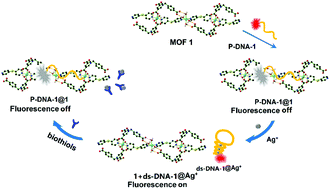Our official English website, www.x-mol.net, welcomes your feedback! (Note: you will need to create a separate account there.)
Sequential Ag+/biothiol and synchronous Ag+/Hg2+ biosensing with zwitterionic Cu2+-based metal-organic frameworks.
Analyst ( IF 4.2 ) Pub Date : 2020/02/25 , DOI: 10.1039/d0an00002g Nai-Han Huang 1 , Yan Liu , Rong-Tian Li , Jing Chen , Pei-Pei Hu , David J Young , Jin-Xiang Chen , Wen-Hua Zhang
Analyst ( IF 4.2 ) Pub Date : 2020/02/25 , DOI: 10.1039/d0an00002g Nai-Han Huang 1 , Yan Liu , Rong-Tian Li , Jing Chen , Pei-Pei Hu , David J Young , Jin-Xiang Chen , Wen-Hua Zhang
Affiliation

|
Zwitterionic metal-organic frameworks (MOFs) of {[Cu(Cbdcp)(Dps)(H2O)3]·6H2O}n (MOF 1) and [Cu4(Dcbb)4(Dps)2(H2O)2]n (MOF 2) (H3CbdcpBr = N-(4-carboxybenzyl)-(3,5-dicarboxyl)pyridinium bromide; H2DcbbBr = 1-(3,5-dicarboxybenzyl)-4,4'-bipyridinium bromide; Dps = 4,4'-dipyridyl sulfide) quench the fluorescence of cytosine-rich DNA tagged with 5-carboxytetramethylrhodamine (TAMRA, emission at 582 nm, denoted as C-rich P-DNA-1) and yield the corresponding P-DNA-1@MOF hybrids. Exposure of these hybrids to Ag+ results in the release of the P-DNA-1 strands from the MOF surfaces as double-stranded, hairpin-like C-AgI-C (ds-DNA-1@Ag+) with the restoration of TAMRA fluorescence. The ds-DNA-1@Ag+ formed on the surface of 1 can subsequently sense biothiols cysteine (Cys), glutathione (GSH), and homocysteine (Hcy) due to the stronger affinity of mercapto groups for Ag+ that serves to unfold the ds-DNA-1@Ag+ duplex, reforming P-DNA-1, which is re-adsorbed by MOF 1 accompanied by quenching of TAMRA emission. Meanwhile, MOF 2 is also capable of co-loading a thymine-rich probe DNA tagged with 5-carboxyfluorescein (FAM, emission at 518 nm, denoted as T-rich P-DNA-2) to achieve synchronous sensing of Ag+ and Hg2+, resulting from the simultaneous yet specific ds-DNA-1@Ag+ and T-HgII-T duplex (ds-DNA-2@Hg2+) formation, as well as the distinctive emission wavelengths of TAMRA and FAM. Detection limits are as low as 5.3 nM (Ag+), 14.2 nM (Cys), 13.5 nM (GSH), and 9.1 nM (Hcy) for MOF 1, and 7.5 nM (Ag+) and 2.6 nM (Hg2+) for MOF 2, respectively. The sequential sensing of Ag+ and biothiols by MOF 1, and the synchronous sensing of Ag+ and Hg2+ by MOF 2 are rapid and specific, even in the presence of other mono- and divalent metal cations or other biothiols at much higher concentrations. Molecular simulation studies provide insights regarding the molecular interactions that underpin these sensing processes.
中文翻译:

基于两性离子型基于Cu2 +的金属-有机框架的连续Ag + /生物硫醇和同步Ag + / Hg2 +生物传感。
{[Cu(Cbdcp)(Dps)(H2O)3]·6H2O} n(MOF 1)和[Cu4(Dcbb)4(Dps)2(H2O)2] n(MOF)的两性离子金属有机骨架(MOF) 2)(H 3 CbdcpBr = N-(4-羧基苄基)-(3,5-二羧基)吡啶鎓溴化物; H2DcbbBr = 1-(3,5-二羧基苄基)-4,4'-溴吡啶鎓; Dps = 4,4'-二吡啶基硫醚)淬灭了被5-羧基四甲基罗丹明(TAMRA,在582 nm处发射,表示为富含C的P-DNA-1)标记的富含胞嘧啶的DNA的荧光,并产生了相应的P-DNA-1 @ MOF杂种。这些杂种暴露于Ag +会导致MOF表面释放P-DNA-1链,成为双链发夹状C-AgI-C(ds-DNA-1 @ Ag +),并恢复TAMRA荧光。1的表面形成的ds-DNA-1 @ Ag +可以随后感测生物硫醇半胱氨酸(Cys),谷胱甘肽(GSH),和高半胱氨酸(Hcy),这是因为巯基对Ag +的亲和力更强,可展开ds-DNA-1 @ Ag +双链体,从而重塑P-DNA-1,MOF 1重新吸附了P-DNA-1,同时淬灭了TAMRA发射。同时,MOF 2还能够共装载用5-羧基荧光素标记的富含胸腺嘧啶的探针DNA(FAM,在518 nm处发射,表示为富含T的P-DNA-2),以实现Ag +和Hg2 +的同步传感,由同时但又特定的ds-DNA-1 @ Ag +和T-HgII-T双链体(ds-DNA-2 @ Hg2 +)形成,以及TAMRA和FAM的独特发射波长引起。对于MOF 1,检测限低至5.3 nM(Ag +),14.2 nM(Cys),13.5 nM(GSH)和9.1 nM(Hcy);对于MOF 2,检测限低至7.5 nM(Ag +)和2.6 nM(Hg2 +)。分别。MOF 1顺序检测Ag +和生物硫醇 甚至在存在更高浓度的其他一价和二价金属阳离子或其他生物硫醇的情况下,MOF 2对Ag +和Hg2 +的同步感测也是快速而特定的。分子模拟研究提供了有关支持这些传感过程的分子相互作用的见解。
更新日期:2020-03-31
中文翻译:

基于两性离子型基于Cu2 +的金属-有机框架的连续Ag + /生物硫醇和同步Ag + / Hg2 +生物传感。
{[Cu(Cbdcp)(Dps)(H2O)3]·6H2O} n(MOF 1)和[Cu4(Dcbb)4(Dps)2(H2O)2] n(MOF)的两性离子金属有机骨架(MOF) 2)(H 3 CbdcpBr = N-(4-羧基苄基)-(3,5-二羧基)吡啶鎓溴化物; H2DcbbBr = 1-(3,5-二羧基苄基)-4,4'-溴吡啶鎓; Dps = 4,4'-二吡啶基硫醚)淬灭了被5-羧基四甲基罗丹明(TAMRA,在582 nm处发射,表示为富含C的P-DNA-1)标记的富含胞嘧啶的DNA的荧光,并产生了相应的P-DNA-1 @ MOF杂种。这些杂种暴露于Ag +会导致MOF表面释放P-DNA-1链,成为双链发夹状C-AgI-C(ds-DNA-1 @ Ag +),并恢复TAMRA荧光。1的表面形成的ds-DNA-1 @ Ag +可以随后感测生物硫醇半胱氨酸(Cys),谷胱甘肽(GSH),和高半胱氨酸(Hcy),这是因为巯基对Ag +的亲和力更强,可展开ds-DNA-1 @ Ag +双链体,从而重塑P-DNA-1,MOF 1重新吸附了P-DNA-1,同时淬灭了TAMRA发射。同时,MOF 2还能够共装载用5-羧基荧光素标记的富含胸腺嘧啶的探针DNA(FAM,在518 nm处发射,表示为富含T的P-DNA-2),以实现Ag +和Hg2 +的同步传感,由同时但又特定的ds-DNA-1 @ Ag +和T-HgII-T双链体(ds-DNA-2 @ Hg2 +)形成,以及TAMRA和FAM的独特发射波长引起。对于MOF 1,检测限低至5.3 nM(Ag +),14.2 nM(Cys),13.5 nM(GSH)和9.1 nM(Hcy);对于MOF 2,检测限低至7.5 nM(Ag +)和2.6 nM(Hg2 +)。分别。MOF 1顺序检测Ag +和生物硫醇 甚至在存在更高浓度的其他一价和二价金属阳离子或其他生物硫醇的情况下,MOF 2对Ag +和Hg2 +的同步感测也是快速而特定的。分子模拟研究提供了有关支持这些传感过程的分子相互作用的见解。



























 京公网安备 11010802027423号
京公网安备 11010802027423号